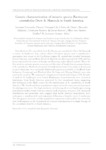Please use this identifier to cite or link to this item:
http://www.alice.cnptia.embrapa.br/alice/handle/doc/1063744| Title: | Genetic characterization of invasive species Bactrocera carambolae Drew & Hancock in South America. |
| Authors: | PASSOS, J. F.  DEUS, E. da G. de   ADAIME, R.   JESUS-BARROS, C. R. de   MULLER, A. van S.   SILVA, J. G.   |
| Affiliation: | JOSEANE FERNANDA PASSOS, UESC; EZEQUIEL DA GLORIA DE DEUS, UNIFAP; RICARDO ADAIME DA SILVA, CPAF-AP; CRISTIANE RAMOS DE JESUS-BARROS, CPAF-AP; ALIES VAN SAUERS MULLER, Ministry of Agriculture, Animal Husbandry and Fisheries, Paramaribo; JANISETE GOMES SILVA, UFSC. |
| Date Issued: | 2016 |
| Citation: | In: MEETING OF THE TEPHRITID WORKERS OF THE WESTERN HEMISPHERE, 9th., 2016. Buenos Aires. Book of Abstracts... [Buenos Aires: FAO: AIEA, 2016]. p. 198. |
| Description: | The carambola fruit fly, Bactrocera carambolae Drew & Hancock is native to Southeast Asia, infests about 150 plant species and is considered a quarantine pest insect in the Caribbean region. B. carambolae invaded Suriname, French Guyana, and northern Brazil. In Brazil it was first recorded in 1996 and has been restricted to the states of Amapá and Roraima under official control. This is the first study to estimate genetic structure and diversity of South American populations of B. carambolae. Methods: A total of 116 individuals from 11 localities in Brazil and seven in Suriname were analyzed. Additional sequences available at GenBank from Indonesia (Lampung) and Thailand (San Pa Tong and Muang District) were also used in the analysis. We sequenced a fragment of mitochondrial gene COI. Results: A total of 35 haplotypes were found. Haplotypes from Indonesia were closest to haplotypes from South America separated by few mutational steps, suggesting that Indonesia is the likely source for the introduction of B. carambolae in South America. The Southeast Asian populations appeared as the most ancestral group in the phylogenetic trees. The high similarity and sharing of several haplotypes among populations within South America indicate lack of genetic structure. The mismatch distribution and neutrality tests suggest that South America populations have undergone a rapid growth and expansion following a founder event. Conclusion: The low genetic diversity and the population expansion evidenced by the neutrality tests lend support to the hypothesis of a recent introduction of a single lineage of the carambola fruit fly in South America. |
| Thesagro: | Praga de planta |
| Keywords: | Diversidade genética Genetic diversity Mosca da fruta Fruit fly Plant pest |
| Type of Material: | Resumo em anais e proceedings |
| Access: | openAccess |
| Appears in Collections: | Resumo em anais de congresso (CPAF-AP)  |
Files in This Item:
| File | Description | Size | Format | |
|---|---|---|---|---|
| CPAFAP2016Geneticcharacterizationofinvasive.pdf | 52,92 kB | Adobe PDF |  View/Open |









